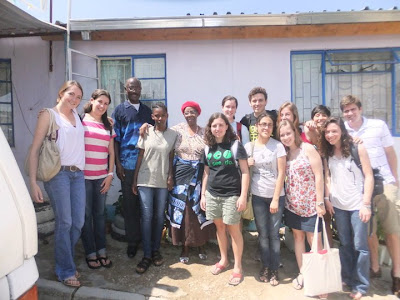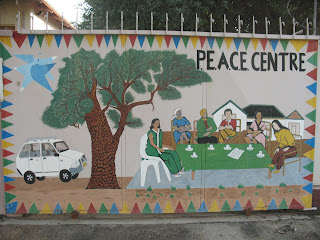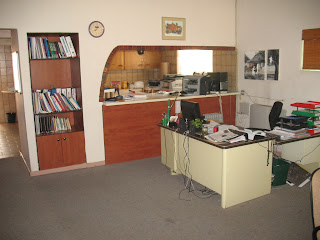In history class we have been learning about the first genocide of the 20th century, the Ova-Herero genocide. It occurred from 1904-1908 and took the lives of over 60,000 Hereros. It is often forgotten in the history books and there is no formal teaching of it in Namibian schools. For the Herero people, it has become a challenge to receive legal compensation for the horrific events. Land rights are also an issue worth fighting for. Before the advent of colonization, the Herero people were the most populated and dominant group in Namibia. The genocide killed off about 80% of the Herero tribe, with many fleeing to Botswana. Today the most populated group in Namibia is the Oshivambo, who weren’t directly affected by the genocide and were in northern Namibia at the time. The genocide has devastated the cultural identity of the people and helped cause a large shift in power away from Herero towards Oshivambo people.
 |
| The Herero grave site |
Only recently in 2007 has the German government made a formal recognition of the events, but no compensation has been given to the people. Every year a day is marked for the event and a ceremony carried out in recognition of the fallen. Finally in 2007 a fence was put up and a plark erected in memory of the victims of the genocide. Before this establishment, people would drive 4-wheeler motorbikes directly over the graves, completely unaware of the thousands of people buried below.
Just outside of Swakopmund you can walk to the graves of the German soldiers with elaborate decorations and plant life. A short walk over is the graves of the Herero people signified by the many mounds in the ground. An arbitrary fence separates the graves from the outside. The problems with mass graves are in the recognition and dignity of the deceased. There are no names and separate representations for anyone. Individuality has been wiped away from the face of recognition. Instead, in the case of this burial site, there is a simple statement that is so elusively written. It says:
“In memory of the thousand of heroic OvaHerero who perished under mysterious circumstances at the realm of their German colonial masters in concentration camps in Swakopmund.”
1904-1908
Rest in Peace
 |
| The plark in dedication to the events of the genocide |
What were the mysterious circumstances? Well for one thing, there was nothing mysterious about the deaths of the Herero people. The Germans kept very good records of each death as it occurred, with a detailed description about the time and method of death. Also, this elusiveness says nothing about the brutal methods that occurred. The events that took place were more than circumstances; they were part of a genocide aimed at wiping out the entire Herero population.
 |
| The German grave site |
The Germans are written as masters to the people, which speak clearly to the problems of bias in historical inquiry. So often are people written in a different light, which changes the way we learn history. The heroes are glorified and in many respects seen as people who can transcend humanity. Another example can be seen with the founding fathers George Washington and Thomas Jefferson in the United States. Both are often taken as saviors of all humanity, but their overt racist thinking and actions are pushed aside. It is important to speak honestly about history which can only be achieved by proper historical inquiry. This looks at the past through a multitude of perspectives and enlarges the lenses. The history of the U.S. and Namibia are not white histories. It is a history of all people from their respective lands, and primarily a history of the people who have lived and experienced the land for the longest period of time. These are people who have the greatest historical connection to the land and can have the most impact in defining the history of the region.
When we look at the records to discover the history the narrator determines to be true, let’s put on a critical lens. Let’s looks past the simple text to determine the author’s motives. Let’s realize that it is only one perspective of a conglomeration of the past events. The best interpretation of history requires an understanding of many perspectives through the most objective inquiry.














